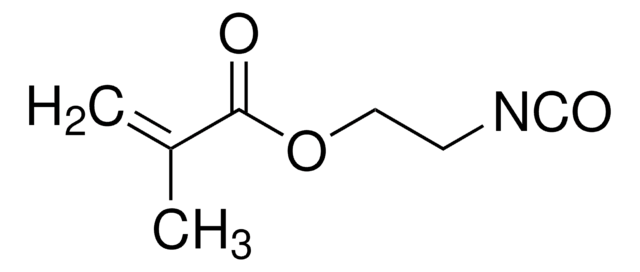305405
Octadecyl isocyanate
≥90%
Synonyme(s) :
1-Isocyanatooctadecane, 1-Octadecyl isocyanate, ODI, Stearyl isocyanate, n-Octadecyl isocyanate
About This Item
Produits recommandés
Pression de vapeur
1 mmHg ( 154 °C)
Essai
≥90%
Indice de réfraction
n20/D 1.45 (lit.)
pb
172-173 °C/5 mmHg (lit.)
Pf
15-16 °C (lit.)
Densité
0.847 g/mL at 25 °C (lit.)
Groupe fonctionnel
amine
isocyanate
Température de stockage
2-8°C
Chaîne SMILES
CCCCCCCCCCCCCCCCCCN=C=O
InChI
1S/C19H37NO/c1-2-3-4-5-6-7-8-9-10-11-12-13-14-15-16-17-18-20-19-21/h2-18H2,1H3
Clé InChI
QWDQYHPOSSHSAW-UHFFFAOYSA-N
Vous recherchez des produits similaires ? Visite Guide de comparaison des produits
Application
- surface of cellulose nanocrystals to promote interfacial filler/matrix interactions[1]
- poly (2-hydroxyethyl methacrylate) (pHEMA) films, to investigate in vitro hemocompatibility assay using freshly drawn human whole blood[2]
- cellulose nanocrystals (or whiskers) and microfibrillated cellulose (MFC)[3]
Mention d'avertissement
Danger
Mentions de danger
Conseils de prudence
Classification des risques
Acute Tox. 4 Dermal - Acute Tox. 4 Inhalation - Acute Tox. 4 Oral - Eye Irrit. 2 - Resp. Sens. 1 - Skin Irrit. 2 - Skin Sens. 1 - STOT SE 3
Organes cibles
Respiratory system
Code de la classe de stockage
6.1C - Combustible acute toxic Cat.3 / toxic compounds or compounds which causing chronic effects
Classe de danger pour l'eau (WGK)
WGK 1
Point d'éclair (°F)
300.2 °F - closed cup
Point d'éclair (°C)
149 °C - closed cup
Équipement de protection individuelle
Eyeshields, Faceshields, Gloves, type ABEK (EN14387) respirator filter
Faites votre choix parmi les versions les plus récentes :
Déjà en possession de ce produit ?
Retrouvez la documentation relative aux produits que vous avez récemment achetés dans la Bibliothèque de documents.
Les clients ont également consulté
Active Filters
Notre équipe de scientifiques dispose d'une expérience dans tous les secteurs de la recherche, notamment en sciences de la vie, science des matériaux, synthèse chimique, chromatographie, analyse et dans de nombreux autres domaines..
Contacter notre Service technique














